Intro
The WTB Vigilante and Trail Boss aren’t new tires, but WTB has released these old favorites in “Plus Curious” — the 2.6” width that is the bike industry’s size du jour at the moment. So we figured we’d see how they compared to the smaller versions.
Across different tire brands, we’ve found that old tread patterns in the new 2.6” size don’t always ride as expected — sometimes they’re similar to their narrower counterparts and just ride a bit “bigger.” But other times we’ve found that the 2.6” versions are very different tires that bring something new to the table (or, in some cases, lose a lot of what made the original versions of the tire great).
We’ve reviewed both the Vigilante and the Trail Boss in the past, so it was time to look at the big(ger) versions of each tire. I should also note that the 2.6’s we’re talking about here aren’t the biggest versions of the tire available — WTB also makes a 2.8” Vigilante and 3.0” Trail Boss, but those are a slightly different story (and that story will have to wait for another day).
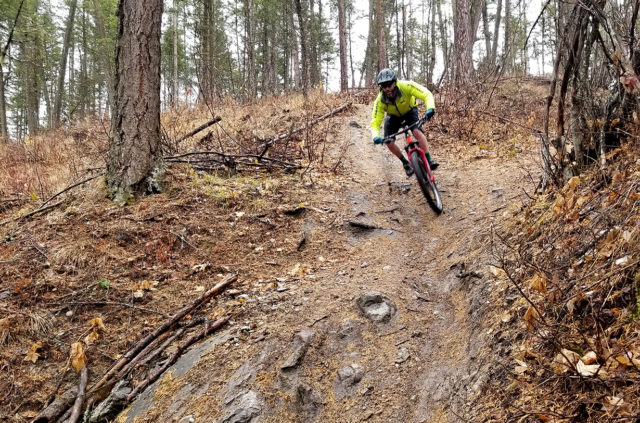
So, on to the tires…
WTB Vigilante
Stated Dimensions: 29” x 2.6”
Measured Width (on 30 mm internal rim):
- 69.1 mm tread width at widest point
- 63.2 mm casing width
Casing tested: TCS Light with Slash Guard
Rubber Compound tested: High Grip
Blister’s Measured Weight: 1223 grams
Mounted to: Trek Slash / Enve M7 Wheels
Intended Use: Big, beautiful traction
MSRP: $83.95 (pricing varies based on tire size / casing)
Reviewer: 5’9” 155 lbs
Test Location: Whitefish, MT
Duration of Test: ~20 rides
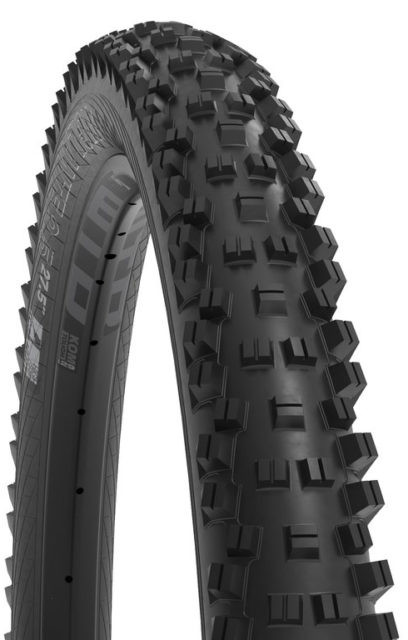
The original Vigilante is, in my opinion, one of the better examples of an aggressive, knobby tire with transitional knobs. By that, I mean that its tread pattern doesn’t have a clear, un-knobbed channel between the center tread and the side knobs. I’ve written more than you probably want to read about that sort of thing in our Mountain Bike Tires 101 Article, so if you want to go down the rabbit hole, check that out.
For now, I’ll slim it down to this: transitional knobs help with moderate cornering, and they help remove the feeling of a loss of cornering traction when the bike is partially leaned over, before the side knobs are fully engaged. The downside is that they can prevent the side knobs from digging in to their fullest potential, so they tend to somewhat limit the ultimate traction that the tire can produce when fully leaned over into a corner.
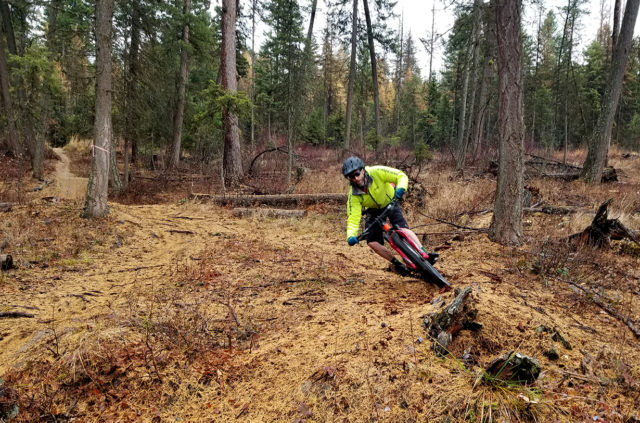
Questions of maximum traction aside, the Vigilante was always good in terms of being predictable, which I’d argue is the most important attribute of any tire. If the tire does the same thing, every time, then I can grow to know it, trust it, and maybe even love it. And that was my experience with the original Vigilante — it was fairly easy to get used to it, and while there are tires that do better in various specific situations, the Vigilante was a good all arounder that I think is a good option for a wide range of riders in any condition where a bigger, nobbier tire is appropriate.
So, that’s the original Vigilante — but we’re here to talk about the new Vigilante 2.6”. Well, the good news here is that it’s pretty similar to the original tire, but more. It’s wider (obviously), heavier (also pretty obvious), cushier (higher volume!), and it offers up more traction in pretty much every respect.
First, wider: the 2.6” Vigilante measures 69.1 mm at the widest point of the tread when mounted on a 30mm-wide (internal width) rim. So that’s a bit over 2.7”, which puts the Vigilante at the big end of 2.6” tires on the market (e.g., it’s about 5 mm wider than a 2.6” Maxxis DHF). And that means the 2.6” Vigilante is more than 10 mm wider than the 2.3” Vigilante that I initially tested (which was 58 mm at its widest point, albeit on a narrower rim).
The 2.6” Vigilante is heavier. My 2.6” Vigilante came with the “Light” casing that also has WTB’s “Slash Guard.” So that’s a single-ply casing with a nylon insert in the sidewall to help prevent slices. My tire weighed in at 1223 grams, which is less than the 1256 grams that WTB advertises for this tire on their site. So the good news here is that you can probably trust WTB’s published weights. And in the grand scheme of things, 1223 grams for a knobby 29” x 2.6” tire like this is about par for the course. Some are a bit lighter, some are a bit heavier, but if a 1200-gram tire isn’t your thing, then you might not be cut out for the 2.6” lifestyle.
Of course, the upside of that 2.6” lifestyle is some extra cush. The 2.6” tires have a higher air volume simply by virtue of being bigger, and that higher volume means (1) you can run lower pressures without risking a pinch flat, and (2) they offer up a nice, smooth ride. It’s a lot of the upsides of the bigger 2.8’s and 3.0’s, except the 2.6’s will fit in most non-plus forks, and quite a few non-plus frames.
In terms of traction, I sometimes find that bigger tires actually do a bit worse than their narrower brethren. A bigger tire means more “float,” but for traction, what I really want is for the tire to dig in hard and grab the dirt, not float above it. Particularly in medium to soft dirts, I’ve found bigger tires, particularly plus tires, don’t actually generate as much traction as it seems like they should. That can take you into a long discussion of widths, tread patterns, and soil types, but to skirt around all of that, I’m happy to report that the 2.6” Vigilante does, in fact, offer up more traction in every respect than the narrower Vigilante options. Climbing: yes, more traction. Braking: yup, they stop really well. Cornering: they’re every bit as predictable as the narrower options, but with even more grip on tap.
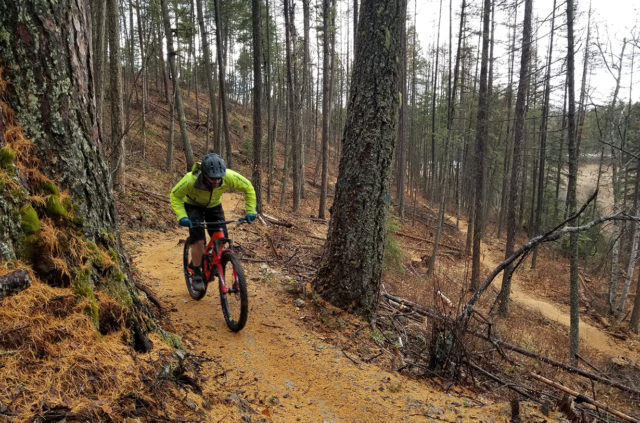
I did get a chance to get the Vigilante out on some late-season wet (and sometimes snowy) trails, which had plenty of opportunities to test traction. And I was pretty pleasantly surprised — the High Grip compound sticks to wet roots reasonably well, and the tread pattern has enough knobs and siping to eek out a bit of extra grip. That, with the higher-volume size and the lower air pressures that I could run, made for a tire that did pretty well in slick, greasy stuff.
Of course, the “more of everything” version of the Vigilante also comes with more rolling resistance. The Vigilante tread pattern is not a renowned XC race tire, and none of the widths roll particularly quickly. The 2.6” is slower than the 2.5”, which is slower than the 2.3”. Shocking, I know. You heard it here first. In the grand scheme of things, I’d call each respective width of the Vigilante pretty average when compared to other similarly knobby tires.
Durability
The High Grip version of the tire I was using runs a softer compound than the “Fast Rolling” compound, but the High Grip compound held up reasonably well for me. The knobs are starting to tear a tiny bit, and the edges are rounding off, but there isn’t any wear that’s raising any red flags. I was running the Vigilante on the front, so the casing took a bit less abuse, but regardless, I didn’t run into any issues with it.
A Note on Mounting
In the past, I’ve had good luck with WTB’s TCS (Tubeless Compatible System) tires. They were tight enough on the rim to make tubeless setup easy, but not so tight that they were overly difficult to install or remove. I’m not sure what’s different about the 2.6” Vigilante I had, but sweet baby Jesus those things are tight. I tried them on a couple different rims (Race Face Next R, Enve M7, & Bontrager Line 30), and the tires were fairly tight on all of them. They were tightest on the Race Face rims, and to remove the tire, I had to use a C-clamp to get enough leverage to remove the 2nd bead, meaning I already managed to get one side of the tire off, and I couldn’t get the other side to break free. These are the only tires I’ve ever had that much trouble with.
And really, it’s mostly uninstalling that’s difficult — getting the tires on isn’t too bad, but once the bead locks in, it’s really tough to break that seal. On one occasion where I had a rim-strip-related slow leak that required repair on the trail, four grown men, most of whom have worked in a bike shop at some point in their lives and have collectively changed 1000’s of flats, were unable to get the tire off to make a trail-side repair. I started carrying a 12 inch long metal motorcycle tire lever with me on rides just in case I got a flat with these tires.
So be forewarned, these tires are really, really tight on some rims.
Bottom Line
If you like the original Vigilante but you want something a bit bigger, I’m confident you’ll be happy with the 2.6” Vigilante. As I said at the outset, some of the 2.6” variations on the market might as well be completely different tires. The Vigilante isn’t one of those — it has all the upsides of the original Vigilante, but with a bit more volume and cush. There are the expected downsides that come with a bigger, heavier tire, but none of those downsides are particularly egregious. Really, the only noteworthy downside I have to report is that, at least on some rims, the tires can be really (really) hard to remove.
WTB Trail Boss
Stated Dimensions: 29” x 2.6”
Measured Width (on 30mm internal rim):
- 67.9 mm tread width at widest point
- 58.9 mm casing width at widest point
Casing tested: TCS Tough
Rubber Compound tested: Fast Rolling
Blister’s Measured Weight: 1294 grams
Mounted to: Trek Slash / Enve M7 Wheels
Intended Use: Bossing trails around
MSRP: $83.95 (pricing varies based on tire size / casing)
Reviewer: 5’9” 155 lbs
Test Location: Whitefish, MT
Duration of Test: ~20 rides

When I rode the narrower versions of the Trail Boss, it landed as sort of a middle-ground tire. It didn’t quite have the traction of something knobbier like the Vigilante, but it rolled a good bit faster. That situated it as a tire occupying the no-man’s land between some of the more XC-oriented tires that largely prioritize fast rolling, and the meatier, knobbier tires that prioritize traction. I preferred the Trail Boss on shorter-travel bikes and “aggressive” hardtails, and while WTB doesn’t explicitly list it as a rear tire, that’s really where it performs best.
Now, I mentioned above that some 2.6” tires, like the Vigilante, are really just a bigger version that’s similar in most respects to its narrower counterparts. And yes, the tread pattern on the 2.6” Trail Boss is, upon initial inspection, very similar to the narrower versions I’ve ridden in the past.
But on the trail, it’s a whole different beast. And I’ve gotta say, I’m a fan.
First, the things that stayed more or less the same. The 2.6” Trail Boss’s center knobs are still similar to the original Trail Boss — there’s a bunch of medium-height, square-ish knobs that are semi-tightly spaced. They’re bigger than what you’d find on most semi-slicks, but they’re still smaller than the center knobs on a full knobby tire like the Vigilante.
So what’s different? The side knobs, mostly. They’re tall. They’re almost a bit reminiscent of a cut mud spike.
Here’s a picture with the (slightly dirty) 2.6” Trail Boss on the right and a 2.4” Trail Boss on the left.
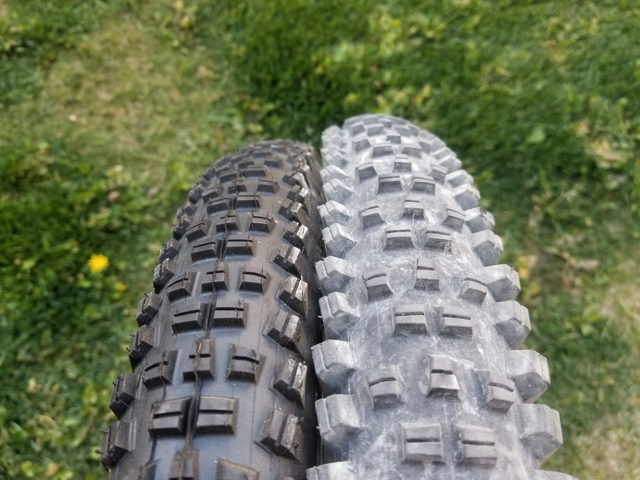
The basic tread pattern is the same, although the center knobs are a little more spaced out on the 2.6” (as you’d expect since there’s a bit more real estate for those knobs to cover). But look at the side knobs — the side knobs on the 2.6” are much, much taller than on the 2.4”. On the 2.4”, both the side knobs and center knobs are about 3.5 mm tall. On the 2.6”, the center knobs get bumped up slightly to 4 mm, but the side knobs almost double in size — just over 6 mm. So it’s noteworthy that (1) the side knobs are way taller relative to the narrower version of the tire, and (2) the center knobs are only slightly taller, meaning that (3) the side knobs relative to the center knobs on the 2.6” stick up a bunch more.
So what you have is a tire with a moderate center tread that offers fairly good climbing and braking traction, but it also has tall, spiky side knobs that can really dig in on hard corners.
The end result is a tire that kind of rides like a semi-slick in that the side knobs offer up disproportionately more traction than the center knobs. But it doesn’t have the “barely any traction in a straight line” effect of a normal semi-slick — the center knobs on the Trail Boss still do a decent job of providing straight-line grip.
On the narrower Trail Boss, it’s definitely possible to push past the medium-sized side knobs and lose traction. On the 2.6” Trail Boss, as long as the dirt is soft, the side knobs offer up impressive grip that puts it into the category of tires that’ll lay a trench through a corner given the proper rider input.
An important note on that, however — the dirt really needs to be soft for these tires to work well. In loam, sand, and other soils where the side knobs can fully dig in, they work great. But the side knobs are fairly tall and not particularly wide, so on harder surfaces, they’re noticeably squirmy. They’re worse in that regard than the Vigilante and, for that matter, many of the other popular big knobby tires.
As with the Vigilante, the 2.6” Trail Boss has the same upsides and downsides with respect to the tire size — they weigh more than the narrower version, but they’re higher volume, which means you can run lower pressures and get a bit more cush and traction.
It’s worth noting that, despite having the same size printed on the sidewall, the Trail Boss measures narrower than the Vigilante, which sets that combo up to work well as a front (Vigilante) and rear (Trail Boss). In running that combo myself, the only downside I found is that the big side knobs on the Trail Boss almost produce more cornering traction than the Vigilante. Or, maybe more accurately, when the Vigilante breaks traction, it does so somewhat gradually and predictably. The Trail Boss is similarly predictable, but much more on or off in the cornering traction department. The Trail Boss wants you to commit and slap the bike into a corner. The Vigilante is much happier gradually leaning in and out of the turn. And just to reiterate, those statements mostly apply to the 2.6” Trail Boss — the narrower versions are different beasts.
In terms of rolling resistance, the 2.6” Trail Boss is noticeably slower than the narrower versions, but it’s still decent as a 2.6” tire. The caveat here is that, similar to some semi-slicks, the Trail Boss doesn’t like to be run on a wider rim (i.e. 35 mm or more). Those wider rims square off the tire profile and cause the tall side knobs to hit the ground while riding in a straight line. This is slow, and also wears out the knobs a lot quicker. A narrower rim (e.g., 30 mm, or even a bit less) allows for a rounder profile that keeps the tire running on the center knobs.
Durability
I ran the Trail Boss with WTB’s “Tough” casing, which is a full 2-ply tire. It’s not a full DH casing, but it’s noticeably heavier and stiffer than any of the single-ply (or reinforced single-ply) options. Note that the 2.6” Trail Boss came in about 70 grams heavier than the 2.6” Vigilante with its reinforced single-ply casing, despite the fact that the Trail Boss measures narrower — that extra weight is undoubtedly due to the 2-ply casing. I didn’t have any issues with tears during my time on the Trail Boss, and based on other WTB tires I’ve run with the Tough casing, they hold up pretty well, even for rocky lift-served riding.
In terms of the tread, the side knobs on my Trail Boss are showing some wear. This is somewhat to be expected — the tall, spiky knobs take a lot of abuse and get bent around a lot. I wouldn’t say they’re wearing unreasonably fast, but I don’t expect this to be the kind of tire that still looks great after hundreds and hundreds of miles.
Mounting
I noted in the Vigilante section above about how tight those tires were on various rims. The Trail Boss was the same way — really, really tight on some rims. Some of the tightest tires I’ve ever worked on. They remind me of the original Intense-branded DH tires (I’m sure some crusty old downhiller will understand that reference).
Bottom Line
Mounting difficulties notwithstanding, I like the 2.6” Trail Boss. The narrower Trail Boss is a tire that I mostly ran on bikes where efficiency and faster rolling was more of a priority, but where I didn’t want to go with a full XC tire.
The 2.6” Trail Boss, on the other hand, is a tire I’d happily put on the rear of any longer-travel Trail bike where I don’t really care all that much about rolling resistance and I’m mostly looking to corner hard and have a good time.
If you’re riding a lot of hardpacked dirt, or if you’re looking for a tread pattern that’s going to last for years, this probably isn’t the tire I’d pick. But for soft dirt, and maybe even for intermittent mud, the 2.6” Trail Boss hooks up in loamy corners better than most tires out there, and it still rolls relatively quickly. It manages to walk the fine line between minimizing rolling resistance, offering up a bunch of traction, and doing all of that in a high-volume 2.6” package. And I think that combo should be pretty dang attractive for a lot of riders.

Great review, love WTB’s new tire lineup.
Curious that 2.4 Trail Boss you mention, is that the old version? It definitely looks like it as the newer 2.4 had much bigger knobs than your pic appears.
Sorry, slow reply on this. But yes – I believe the 2.4’s I have are the older version. I know WTB tweaked the side knobs, but I haven’t gotten my hands on the new version to compare them to the older 2.4’s (or the newer 2.6’s).
-Noah
Looking for tyres for mountain bike Tyers I have are 26×260 looking for same can you surply them